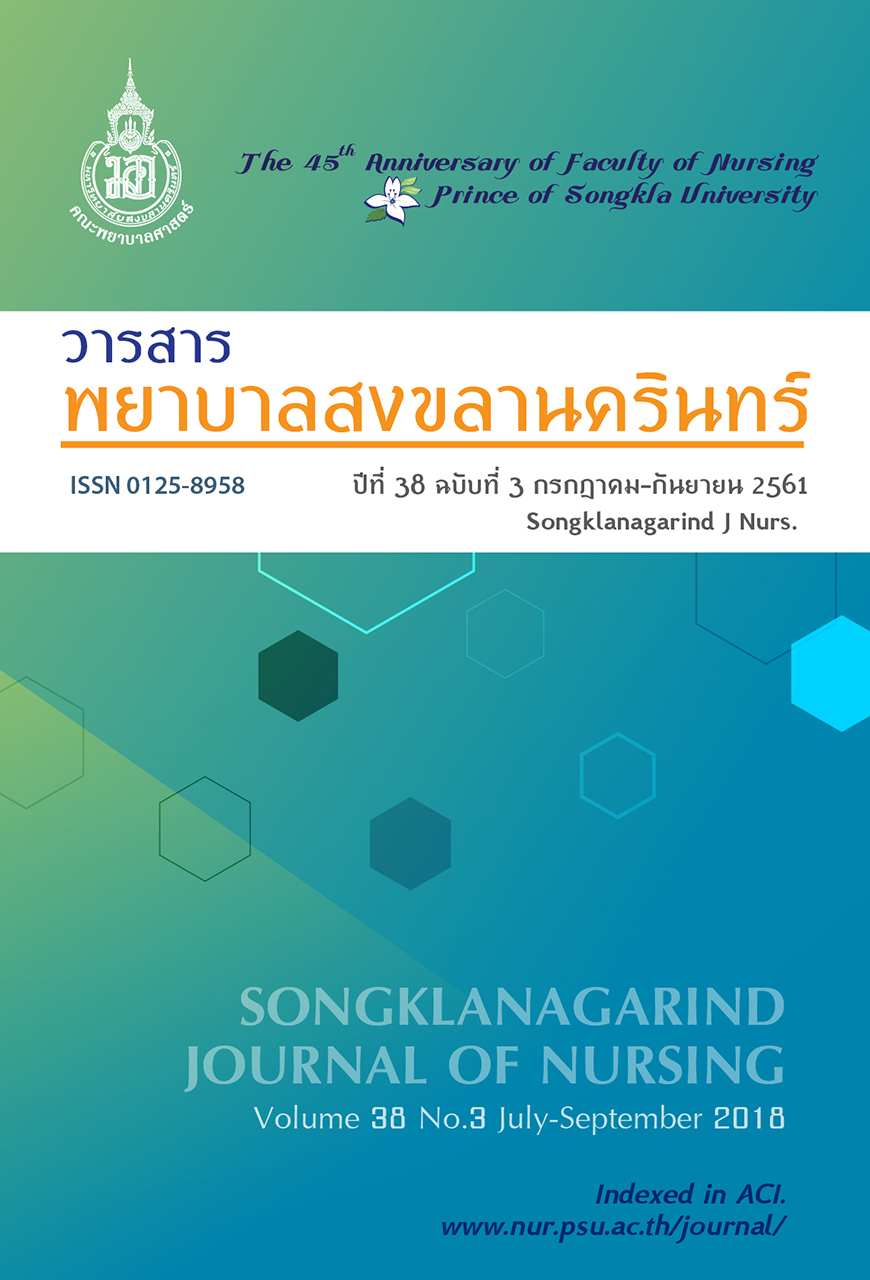ผลของโปรแกรมสนับสนุนและแอปพลิเคชันให้ความรู้ต่อพฤติกรรม การดูแลของผู้ดูแลทารกแรกเกิดที่มีภาวะตัวเหลือง และได้รับการรักษาโดยการส่องไฟ
Main Article Content
บทคัดย่อ
การวิจัยกึ่งทดลอง เพื่อศึกษาผลของโปรแกรมสนับสนุนและแอปพลิเคชันให้ความรู้ต่อพฤติกรรมการดูแลของผู้ดูแล
ทารกแรกเกิดที่มีภาวะตัวเหลืองและได้รับการรักษาโดยการส่องไฟ กลุ่มตัวอย่าง คือ ผู้ดูแลทารกแรกเกิดตัวเหลืองที่ได้รับการ
ส่องไฟ จำนวน 30 ราย แบ่งเป็นกลุ่มควบคุมและกลุ่มทดลอง กลุ่มละ 15 ราย เลือกกลุ่มตัวอย่างแบบเจาะจง กลุ่มทดลอง
ได้โปรแกรมสนับสนุนและแอปพลิเคชันให้ความรู้ ประกอบด้วย 1) สอนผ่านสื่อแอปพลิเคชันให้ความรู้ 2) ชี้แนะ ติดตามให้
ตระหนักในการดูแล 3) สนับสนุน ส่งเสริมให้มั่นใจในการดูแลอย่างต่อเนื่อง และ 4) จัดสิ่งแวดล้อม สาธิตวิธีการปฏิบัติที่ชัดเจน
กลุ่มควบคุมได้รับการพยาบาลปกติ เครื่องมือเก็บรวบรวมข้อมูลคือ แบบสอบถามพฤติกรรมการดูแลของผู้ดูแลทารกแรกเกิด
ตามกรอบแนวคิดของโอเร็ม วิเคราะห์ข้อมูลด้วยสถิติ Independent t–test และ Paired t-test
ผลการวิจัยพบว่า 1) หลังการทดลอง กลุ่มทดลองมีคะแนนเฉลี่ยพฤติกรรมการดูแลสูงกว่ากลุ่มควบคุมอย่างมีนัยสำคัญ
ทางสถิติที่ระดับ .05 และ 2) หลังการทดลองกลุ่มทดลองมีคะแนนเฉลี่ยพฤติกรรมการดูแลสูงกว่าก่อนการทดลองอย่างมี
นัยสำคัญทางสถิติที่ระดับ .05
โปรแกรมสนับสนุนและแอปพลิเคชันให้ความรู้สามารถใช้เป็นแนวทางในการพยาบาล เพื่อส่งเสริมพฤติกรรมของผู้ดูแล
ให้สามารถดูแลทารกแรกเกิดที่มีภาวะตัวเหลืองและได้รับการรักษาโดยการส่องไฟได้อย่างถูกต้องและต่อเนื่อง
Article Details
References
2. Thai Neonatal Society. Newborn care guilde. Bangkok: Thai Neonatal Society; 2008. Thai.
3. Information Technology Department. Annual statistical report. Nakhon Phanom: Nakhon Phanom Hospital; 2017. Thai.
4. Prawannao N, Kiatchoosakun P, Jirapradittha J, et al. Neurodevelopment outcomes of infant with severe hyperbilirubinemia in Srinagarind Hospital. Thai journal of pediatrics. 2012;51(2):120-26. Thai.
5. Prasomsak K. Effect of an educative and supportive program on the anxiety of parents who have infants with hyperbilirubinemia and received phototherapy during the postpartum period. [thesis].[Bangkok]: Mahidol University; 2008. 61p. Thai.
6. Siriboonpipattana P. Pediatric Nursing Volume 1. Nonthaburi, Praboromarajchanok Institute Welfare Fund: Ministry of Public Health; 2012. Thai.
7. Kiatchoosakun P. Neonatal hyperbilirubinemiain: In: Kirdpon S, editor. Pediatrics. Khon Kaen: Anna Offset Printing; 2009. Thai.
8. Boonyarittipong P, Boonlueang W, Tantrachee- wathorn S. Effectiveness of intensive phototherapy in neonatal hyperbilirubinemia. Vajira Med J. 007; 51(1): 1-8. Thai.
9. Chantanamongkon K. Pediatric Nursing. Samut-Prakan, M&M Laser Print Limited Partnership; 2011. Thai.
10. Dejputtawat W, Chamnanvanakij S. Efficacy of fluorescent lamp vs Light-Emitting Diodes (LED) photo dome for the treatment of neonatal hyper-bilirubinemia. RTA Med J. 2016;69 (2):115-21. Thai.
11. Yoosiri B. The development of clinical nursingpractice guidelines in harmful prevention of neonatal jaundice in-term newborn. [thesis].[Bangkok]: Christian University; 2557. 71 p. Thai
12. Supaporn J, Klunklin P, Urharmnuay M. Receiving phototherapy and related factors. Nursing Journal. 2013,40(1):115-26. Thai.
13. Mishu H, Ming CL, Hsiu HH, et al. Risk factor analysis for late-onset neonatal hyperbilirubinemia in Taiwanese infants. Pediatr Neonatol. 2009; 50(6): 261-5. doi: https://doi.org/10.1016/S1875-9572(09)60074-7
14. Phumket W, Thato R. The effects of the perceived self-efficacy promoting program through coachingon the caring behaviors of premature infants of first-time adolescent mothers. [thesis]. [Bangkok]: Chulalongkorn University; 2551. 76 p. Thai.
15. Mornthawee S, Thato R. The effect of coachingprogram on maternal behavior to prevent breast feeding jaundice in full term neonate. [thesis].[Bangkok]: Chulalongkorn University; 2558. 67 p. Thai.
16. Orem DE. Nursing concepts of practice. St Louis: Mosby-Year Book; 1991.
17. Polit DF, Beck CT. Nursing: principle and methods. Philadelphia: Lippincott Williams & Wilkins; 2004
18. Salaprakhon C. Effects of knowledge and behavior development of mothers based on Bandura conceptin caring forneonatal hyperbilirubinemia undergoing phototherapy. [thesis]. [Khon Kaen]: Khon Kaen University; 2555. 59 p. Thai.
19. Srisuphanthawong L. Effect of the teaching pattern on knowledge and caring behaviors of family having patient with leg fracture after surgery. Journal of Faculty of Nursing. 2005;28(2):26-31. Thai

